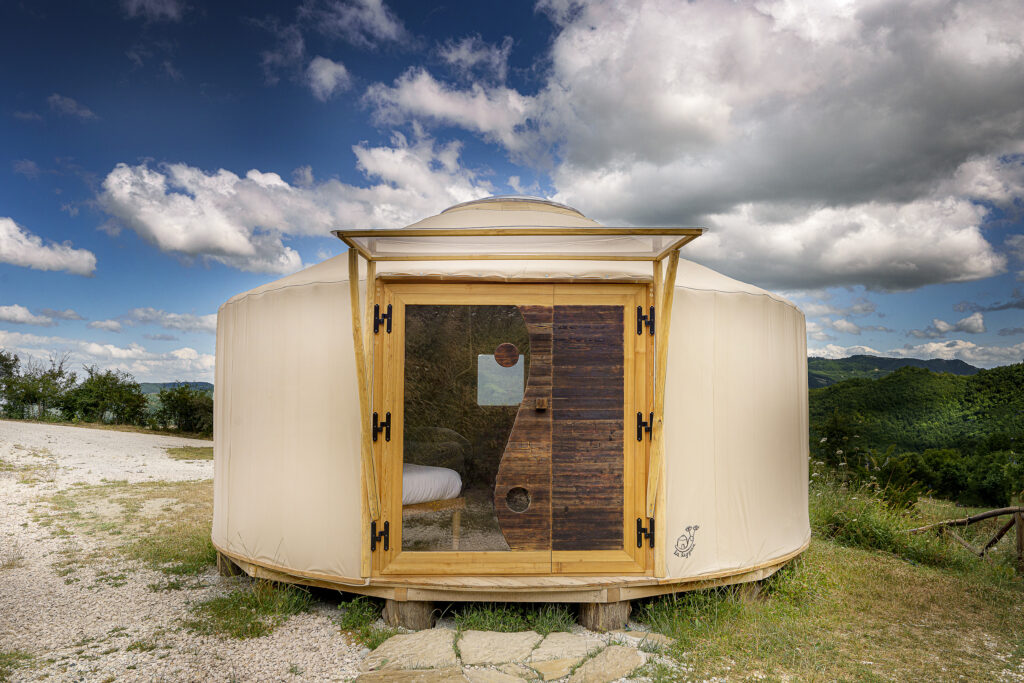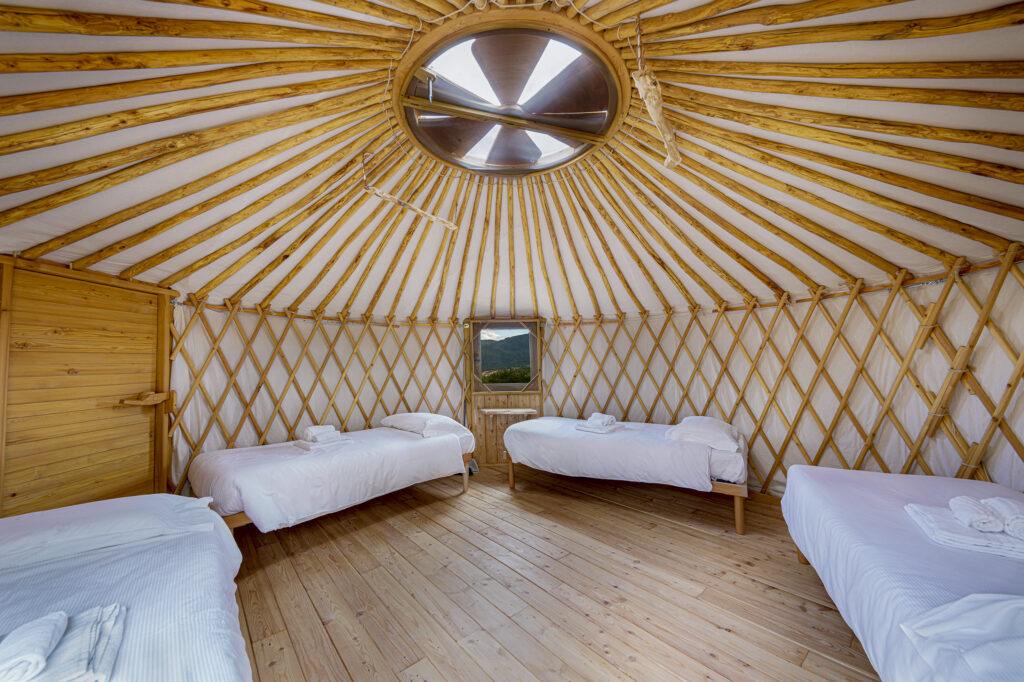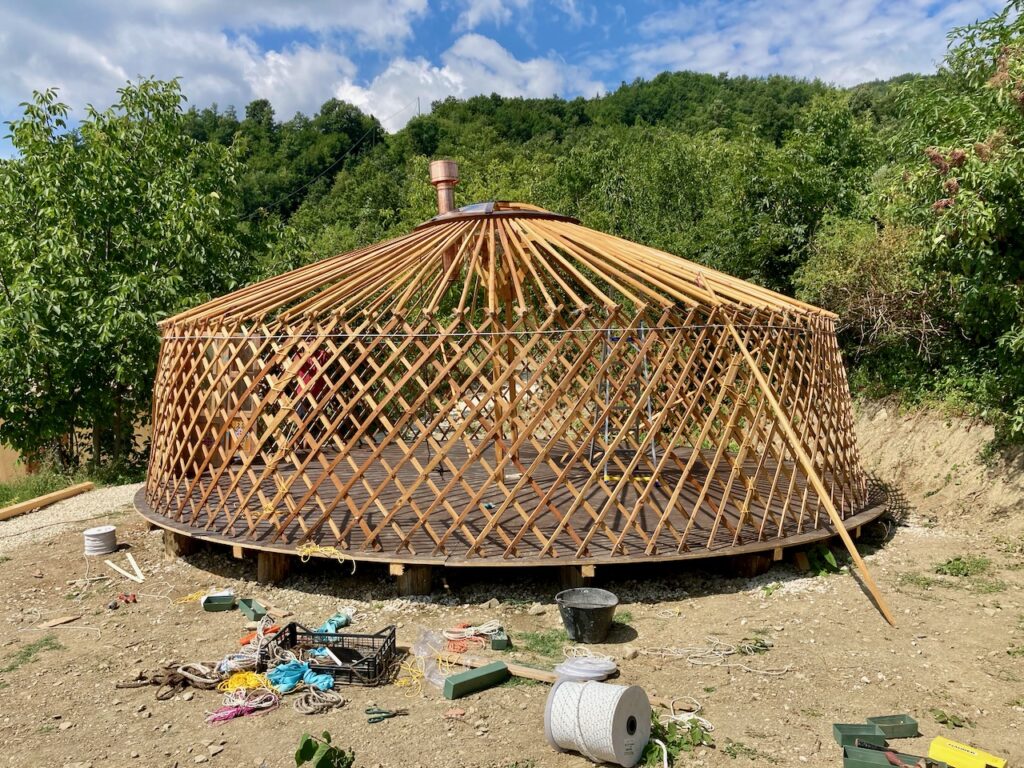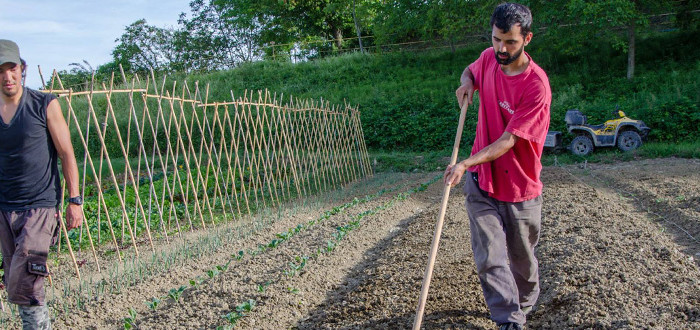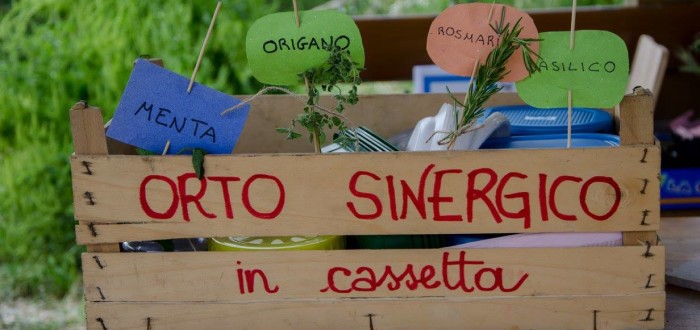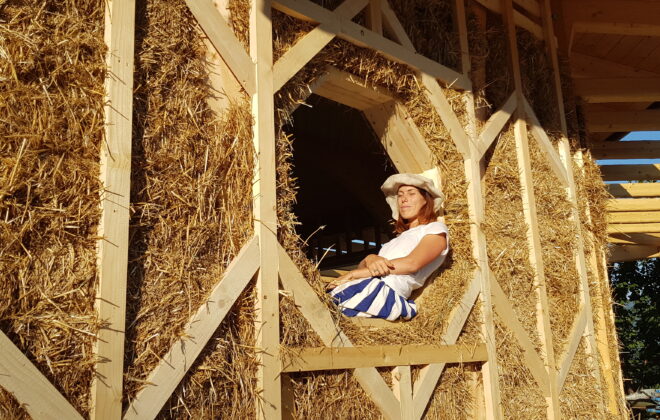The yurts of Autosufficienza
When the Autosufficienza project was born in 2009, the place had not been inhabited for fifty years and the land had not been cultivated for twenty years.
There was no usable covered space. In 2010, in order to have a minimum base of support, we built a compost toilet (dry toilet) and ordered a yurt directly from Mongolia through Silent Breeze (a company that is no longer operational).
The yurt is the typical dwelling of the Mongolians but also of other neighbouring countries that are nomads by nature and usually move every 6 months. It is an easily assembled and disassembled structure comparable to a tent but with the advantage of having excellent insulation, which is traditionally made of felt (sheep, goat, camel, yak, etc.).
The first yurt, made self-sufficient thanks to a photovoltaic panel, a micro-wind turbine, a gel battery and a small wood stove, was initially a multifunctional space where we slept, ate and held classes, then became the woofers’ (volunteers’) dormitory and finally today a guest room for the camp’s guests.
In 2021, a new yurt, this time made in Italy, arrived in the agricamping for guests (laleggera140.wixsite.com/my-site). Compared to the original yurts, it is taller, sturdier and brighter. As insulation instead of felt, hemp was used, which is better suited to our climate, especially winter humidity.
Unlike traditional yurts where the fabrics are several overlapping pieces and held in place by ropes pulled tightly around the circumference, the outer fabric is a single piece and is screwed to the top of the hoop, the platform and all the edges of the frames. This ensures greater safety in the event of strong winds. Furthermore, externally there are no ropes that wear out the fabric a lot, the only structural holding rope is a stainless steel cable that holds the wooden structure and runs inside.
The yurts on the farm have basic furnishings, with untreated wooden floors, LED lighting and 4 and 6 beds respectively. They do not have a bathroom, which is in a separate structure.
What permits are needed to install a yurt?
The same as for putting up a tent if no foundations, masonry work or permanent connections are made.
Each municipality has different legislation on the possibility of placing tents in private, agricultural, etc. areas.
Where is it possible to buy a yurt?
The ever-growing demand has meant that the supply has also grown in Italy. On the internet you can find various sellers, some produce others import.
We got on very well with Diego Carletti (laleggera140.wixsite.com/my-site). He also helped us renovate the old yurt, which after 10 years needed a bit of maintenance.
How much does a yurt cost?
The price varies depending on the diameter, origin, number of frames, finish, etc.
To give an indication, the first yurt we bought in 2010 with a diameter of 6.5 metres cost 5,000 euro. The second purchased in 2021 with a diameter of 5 metres cost 7,500 euros. Over the past year, prices have risen further.
Then there is always the need to make a platform on which to place the yurt. We have always self-built it from chestnut and larch wood with an approximate cost of 1,000 euro.
What maintenance work is needed?
During the winter it would be good to light the stove from time to time, especially when it is cold because the felt suffers a lot from moisture.
Every 3-4 years, the outer UV protection sheet should be replaced.
Related Posts
Le yurte dell’Autosufficienza
Quando nel 2009 nacque il progetto Autosufficienza il luogo non era più abitato da cinquant’anni e i terreni non erano più coltivati da vent’anni.
Non esisteva nessun spazio coperto agibile. Nel 2010 per avere una base minima di appoggio costruimmo una compost toilette (bagno a secco) e ordinammo tramite Silent Breeze (società non più operativa) una yurta direttamente dalla Mongolia.
La yurta è la tipica abitazione dei mongoli ma anche di altri paesi limitrofi che per natura sono nomadi e abitualmente si spostano ogni 6 mesi. È una struttura facilmente montabile e smontabile equiparabile ad una tenda ma con il vantaggio di avere un’ottima coibentazione che tradizionalmente è di feltro (peli di pecora, capra, cammello, yak, ecc.).
La prima yurta, resa autosufficiente grazie ad un pannello fotovoltaico, una micropala eolica, una batteria al gel e una piccola stufa a legna è stata inizialmente uno spazio multifunzionale dove dormivamo, mangiavamo e tenevamo corsi, per poi diventare il dormitorio dei woofers (volontari) e infine oggi diventata camera per gli ospiti dell’agricampeggio.
Nel 2021 nell’agricampeggio, sempre dedicata agli ospiti, è arrivata una nuova yurta, questa volta Made in Italy (laleggera140.wixsite.com/my-site). Rispetto alle Yurte originarie è più alta, più robusta e più luminosa. Come coibentante al posto del feltro è stata usata la canapa, più adatta al nostro clima soprattutto all’umidità invernale.
A differenza delle yurte tradizionali dove i tessuti sono più pezzi sovrapposti e tenuti fermi da corde ben tirate sulla circonferenza, il telo esterno è un pezzo unico e viene avvitato in alto al cerchio, alla pedana e su tutti i bordi degli infissi. Questo garantisce una maggiore sicurezza in caso di forti venti. Inoltre esternamente non ci sono corde che usurano molto il tessuto, l’unica corda di tenuta strutturale è un cavo di acciaio inox che contiene la struttura in legno e passa all’interno.
Le yurte della Fattoria hanno un arredo essenziale, con pavimento in legno non trattato, illuminazione a led e rispettivamente 4 e 6 letti. Non dispongono di bagno che è in struttura distaccata.
Che permessi sono necessari per installare una yurta?
Gli stessi che servono per mettere una tenda se non si fanno fondazioni, opere murarie o allacci permanenti.
Ogni comune ha una legislazione differente sulla possibilità di posizionare tende in ambito privato, agricolo, ecc.
Dove è possibile acquistare una yurta?
La domanda sempre in crescita ha fatto si che anche l’offerta crescesse in Italia. Su internet è possibile trovare diversi venditori, alcuni producono altri importano.
Con Diego Carletti (laleggera140.wixsite.com/my-site) noi ci siamo trovati molto bene. Ci ha fatto anche assistenza per ristrutturare la vecchia yurta che dopo 10 anni aveva bisogno di un po’ di manutenzione.
Quanto costa una yurta?
Il prezzo cambia a seconda del diametro, provenienza, numero di infissi, rifiniture, ecc.
Per dare un’indicazione la prima Yurta che acquistammo nel 2010 con un diametro di 6,5 metri costò 5.000 euro. La seconda acquistata nel 2021 con un diametro di 5 metri è costata 7.500 euro. Nell’ultimo anno i prezzi sono ulteriormente aumentati.
Va poi sempre considerata la necessità di fare una piattaforma su cui poggiare la yurta. Noi l’abbiamo sempre autocostruita a palafitta in legno di castagno e larice con un costo indicativo di 1.000 euro.
Quali lavori di manutenzione sono necessari?
Durante l’inverno sarebbe bene accendere ogni tanto la stufa, soprattutto quando è freddo perché il feltro soffre molto l’umidità.
Ogni 3-4 anni è necessario sostituire il telo esterno di protezione anti UV.
Newsletter
ARGOMENTI
- Activities (8)
- Attività (10)
- Attrattive (16)
- Cosa fare (22)
- Farm products (4)
- Fattoria dell'autosufficienza (39)
- Fattoria dell'autosufficienza (51)
- Fauna (8)
- Flora (5)
- I nostri modelli (14)
- Istruzioni per viaggiare (2)
- News (63)
- News (96)
- Our models (14)
- Permacultura (30)
- Permaculture (23)
- Prodotti della fattoria (4)
- Senza categoria (4)
- Senza categoria (2)
- Things to do (22)
- Tourist attractions (15)


